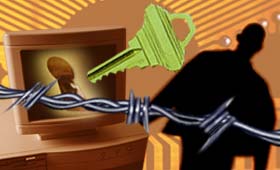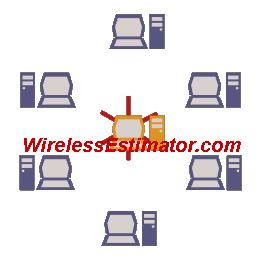
Product Information
Wi-Fi Specialists
Wireless Fidelity is the hottest ticket in town. The ultra fast, low-cost broadband networks let laptop computer users surf the net while gingerly sipping grande lattes in coffee shops or send e-mails from the sanctuary of a public park. It’s in some trains, planes, and as technology evolves, you’ll find it in automobiles. Wi-Fi is titillating. Wi-Fi is liberating. Wi-Fi is going to capture more than $6 billion in revenue for equipment manufacturers and support services by 2008 when hot spots will approach 100,000, according to published reports.
Several large companies are latching on to the Wi-Fi craze by introducing access points, including telecommunications giants SBC Communications and Verizon Communications. Wireless visionary and Chairman of T-Mobile USA, John Stanton budgeted $100 million behind T-Mobile’s Wi-Fi initiative and quickly captured almost 3000 locations in Starbucks, airport and bookstore locations. Wayport Inc. is also one of the largest players in the country. Other Wi-FI entrees include AT&T Wireless which is providing high-speed data services in six of Amtrak’s busiest train stations along the Northeast corridor.
Carriers are recognizing that even when their 3G network is up-and-running, it can’t compare with Wi-Fi’s speed and capacity and they’re looking for a stronger play by bundling both technologies. Sprint PCS has invested in Wi-Fi access consolidator Boingo, the wireless internet service provider that, through a roaming agreement, has close to 2,600 hot-spot locations. Wi-Fi provider Wayport’s hot spots are being resold by, Verizon Wireless and Sprint PCS to counteract T-Mobile’s expanding market share. By 2007 it is expected that more Americans will access mobile data via Wi-Fi than 2.5-generation or third-generation networks. Many Wi-Fi hot spots don’t allow the users to roam across providers, but recent agreements between MCI and Boingo Wireless will allow customers to access either service while continuing to pay just one bill. Similar deals are being considered by the major providers. Sprint PCS has invested in Wi-Fi access consolidator Boingo, the wireless internet service provider that, through a roaming agreement, has close to 2,600 hot-spot locations. Wi-Fi provider Wayport’s hot spots are being resold by, Verizon Wireless and Sprint PCS to counteract T-Mobile’s expanding market share. By 2007 it is expected that more Americans will access mobile data via Wi-Fi than 2.5-generation or third-generation networks. Many Wi-Fi hot spots don’t allow the users to roam across providers, but recent agreements between MCI and Boingo Wireless will allow customers to access either service while continuing to pay just one bill. Similar deals are being considered by the major providers.
iPass has also become a market leader with more than 10,000 active hot spots in its global network that includes North America, South America, Europe, Asia and Africa.
Would you care for fries with that e-mail?
McDonalds will now super size your lunch tab in Chicago, New York City and San Francisco at $4.95 for an hour of internet access. Major hotels, booksellers and coffee shops are providing complementary hot spot service or charging minimal fees.
In the post boom wireless economy, Wi-Fi is providing an  invigorating infusion of profitable opportunities, but an industry shakeout will rear its head as the already inexpensive equipment costs become increasingly lower through technological advances. Price erosion is going to force some ISPs under. The ones that survive will have to provide localized solutions - likely targeting enterprise segments where the margins are better. Wireless service providers will have a higher survival rate, doing installations and site surveys. invigorating infusion of profitable opportunities, but an industry shakeout will rear its head as the already inexpensive equipment costs become increasingly lower through technological advances. Price erosion is going to force some ISPs under. The ones that survive will have to provide localized solutions - likely targeting enterprise segments where the margins are better. Wireless service providers will have a higher survival rate, doing installations and site surveys.
Access points are relatively easy to operate and maintain and some analysts believe that hotels, restaurants, airports and other popular laptop locations will simply install them on their own through suppliers and contractors specializing in Wi-Fi installations. Pay phone booths and kiosks are quickly molting from the dying dinosaur to a profitable source of Wi-Fi revenue opportunities.
Intel inside first casualty
Cometa Networks, a company launched by Intel, IBM and AT&T, was the first major Wi-Fi casualty when it announced in May of 2004 that it was shutting down its network due to inadequate external financing. Cometa had an ambitious goal of bundling more than 20,000 hot spots into one nationwide network, converting the grass-roots popular phenomenon into a billable business. Investor capital was not forthcoming because investment firms did not perceive a  sufficient financial return. sufficient financial return.
Pricing for Wi-Fi equipment is project specific. We recommend that you contact our valued Wi-Fi specialists for your design and product requirements
Wi-Fi standards are various and evolving
Wireless Fidelity is primarily a technical standard for short-range data transmissions within an unlicensed radio frequency. The Wi-Fi Alliance, formerly The Wireless Ethernet Compatibility Alliance, a leading standards body for wireless networking, monitors the alphabet soup of IEE versions 802.11a, 802.11b, and 802.11g.
Equipment certification by the Wi-Fi Alliance assures that people who visit locations using Wi-Fi certified equipment will be able to get connected whether they use 802.11b, 802.11g or dual band 802.11a/g products.
The original "Wi-Fi," based on the 802.11b standard that operates  in the 2.4GHz range, is used by more than 15 million people. Standard 802.11a has its devotees who say it allows wireless signals to routinely pass through heavy stone and masonry walls that would block 802.11b/g signals. in the 2.4GHz range, is used by more than 15 million people. Standard 802.11a has its devotees who say it allows wireless signals to routinely pass through heavy stone and masonry walls that would block 802.11b/g signals.
New products are being certified under 802.11g as being interoperable with the 2.4GHz and 5GHz bands. The FCC is proposing an additional 255 MHz of unlicensed spectrum in the in the 5GHz range, 5.470-5.725, a licensed spectrum in the UK.
Transmission ranges can sacrifice speed
Wi-Fi carries two way radio signals between a fixed base station and one or more laptop computers or some other wireless device such as a personal digital assistant. Transmissions have a range of some 350 feet outside and 80 feet indoors at full speed and longer ranges at reduced speeds.
Some R&D announcements proudly shout out that by tweaking the current technology their new offerings will extend ranges considerably at data rates at 10MPs or better. One San Francisco-based company recently introduced a new antenna technology that  is supposed to give Wi-Fi access points a range of up to four miles. is supposed to give Wi-Fi access points a range of up to four miles.
New computers, desktops as well as laptops, come equipped for wireless. The newest laptops and desktops, powered by Intel’s Centrino, are customized for Wi-Fi. Other computers can be adapted with a plug-in-card for less than $50.00.
Whenever you bring your PDA or laptop within range of an access point hot spot, an onscreen icon names available wireless networks and gives their speed and signal strength. Some require a user name and password. Once connected, you can open a web browser and go onto the internet or handle e-mail through your internet provider’s web-page mail interface. If you’re running Windows XP, you’re up and running immediately and you’re accorded an additional layer of security.
In-building LAN installations prove to be a growth industry
Small businesses, corporate campuses, schools and colleges, and  government agencies are all weighing the benefits of installing a wireless LAN network to support all levels of staffing. Running Ethernet cables and wiring through a building can cost thousands of dollars and fixed work stations lack efficiency. Installing a wireless network allows employees to take their laptops anywhere in the building or campus and remain connected to their network. Conference room cable diving competition is eliminated and increased productivity can be documented. government agencies are all weighing the benefits of installing a wireless LAN network to support all levels of staffing. Running Ethernet cables and wiring through a building can cost thousands of dollars and fixed work stations lack efficiency. Installing a wireless network allows employees to take their laptops anywhere in the building or campus and remain connected to their network. Conference room cable diving competition is eliminated and increased productivity can be documented.
Having access points closer together, one for 16-20 users allows for greater bandwidth for the transfer of large files and applications.
Wireless service companies will perform a site survey in order to  capture enough information and data to determine the number and placement of access points that will provide the coverage required for the location. Radio frequency radiation patterns will have differing attenuation levels in the office environment as a result of employees, walls, doors, elevator shafts and business products. Coverage required usually means the support of a minimum data rate in a given area. An RF site survey will also detect the presence of radio interference coming from other sources that could degrade the performance of the wireless LAN. capture enough information and data to determine the number and placement of access points that will provide the coverage required for the location. Radio frequency radiation patterns will have differing attenuation levels in the office environment as a result of employees, walls, doors, elevator shafts and business products. Coverage required usually means the support of a minimum data rate in a given area. An RF site survey will also detect the presence of radio interference coming from other sources that could degrade the performance of the wireless LAN.
System security slows Wi-Fi acceptance
The stories of hackers driving around in cars, breaking into wireless LANs with off-the-shelf tools such as AirSnort or WEPcrack have become commonplace. However, the biggest security risk for Wi-Fi networks is that users sometimes fail to turn on their encryption  software. But even the responsible ones who use the encryption program -- Wired Equivalent Privacy (WEP)-- aren't immune to attacks. A hacker using a statistical analysis tool can crack a WEP key from a wireless LAN with typical levels of traffic in hours. WEP has been under fire from critics who believe it is too easy to circumvent. software. But even the responsible ones who use the encryption program -- Wired Equivalent Privacy (WEP)-- aren't immune to attacks. A hacker using a statistical analysis tool can crack a WEP key from a wireless LAN with typical levels of traffic in hours. WEP has been under fire from critics who believe it is too easy to circumvent.
The Wi-Fi Alliance's new specifications, called WPA (Wireless Protected Access), include mechanisms from the Institute of Electrical and Electronic Engineers (IEEE) 802.11i standard for both data encryption and network access control.
For encryption, WPA specifies TKIP (Temporal Key Integrity Protocol), which uses the same algorithm as WEP, but constructs keys in a different way. With WPA, each user will have his or her own encryption key, which can be set to change periodically. keys in a different way. With WPA, each user will have his or her own encryption key, which can be set to change periodically.
Existing WEP products will require a software upgrade because you can’t mix WEP and WPA products.
The Wi-Fi Alliance notes, however, that neither WEP nor WPA has been designed to act as the sole security mechanism protecting a network, and it’s advisable to implement other security solutions such a firewall or Virtual Private Network.
I’m okay, you’re okay
When the US Military Academy at West Point went wireless they were required to meet stringent security plans as detailed in Federal Information Processing Standard 140-2. Their wireless wall engineered for the system created a secure data tunnel which requires mutual authentication, where the client must prove its identity to the service and the service has to identify itself to the client.
|